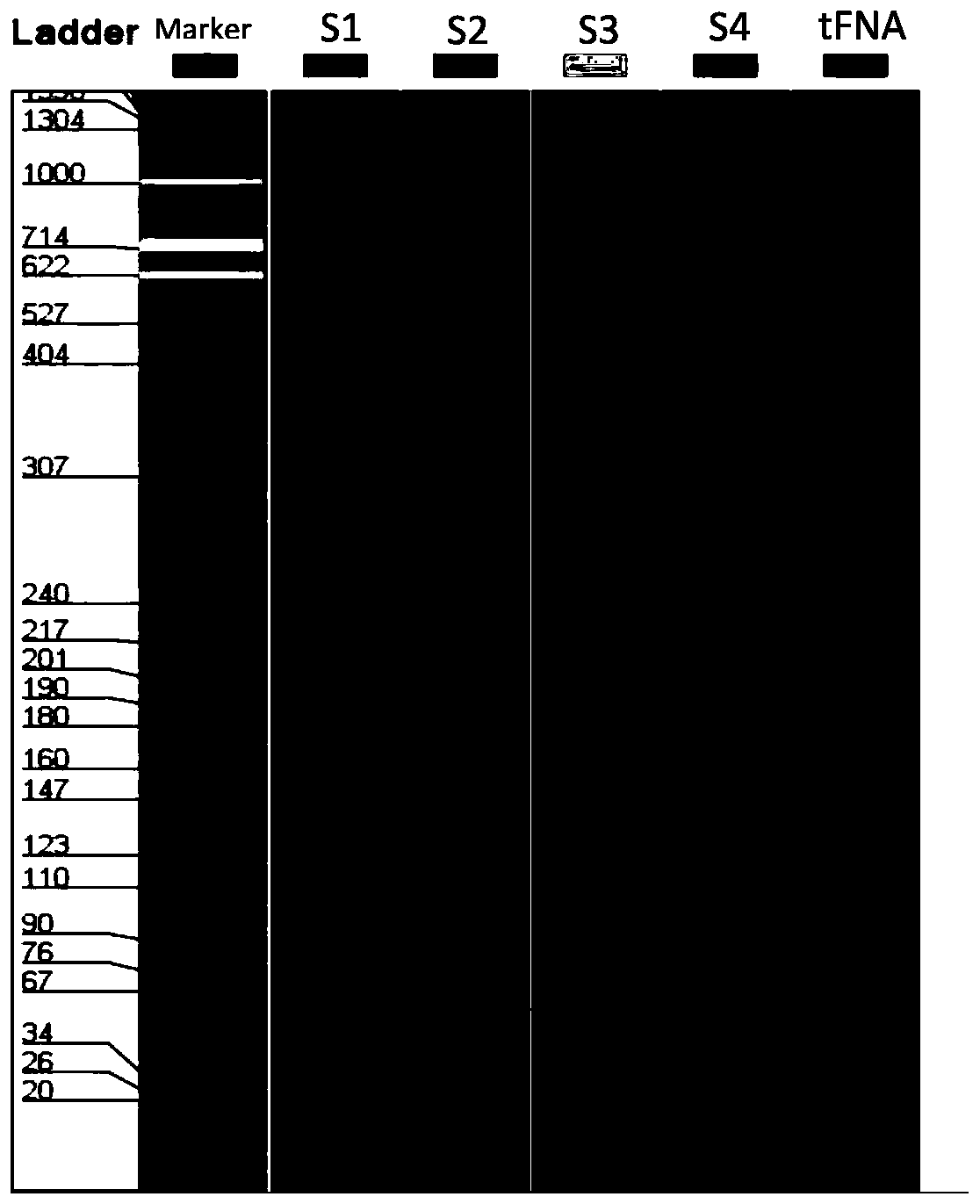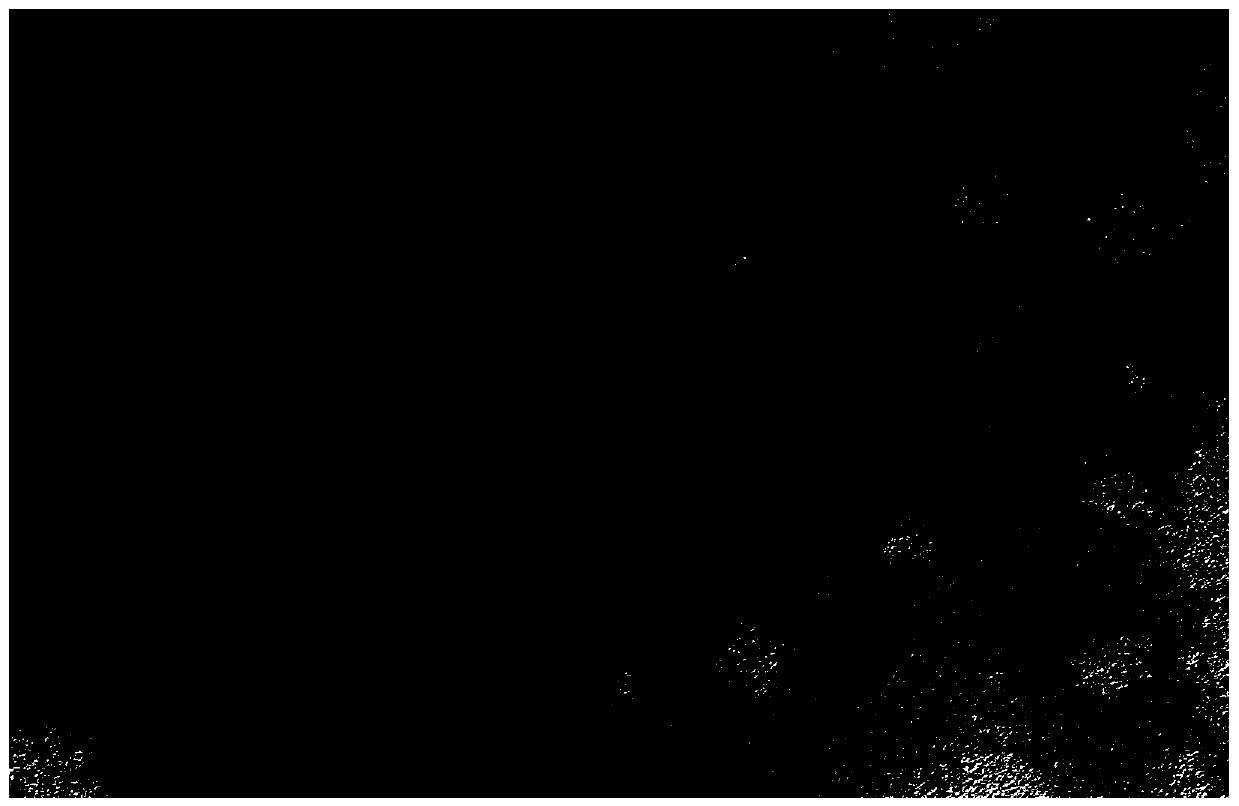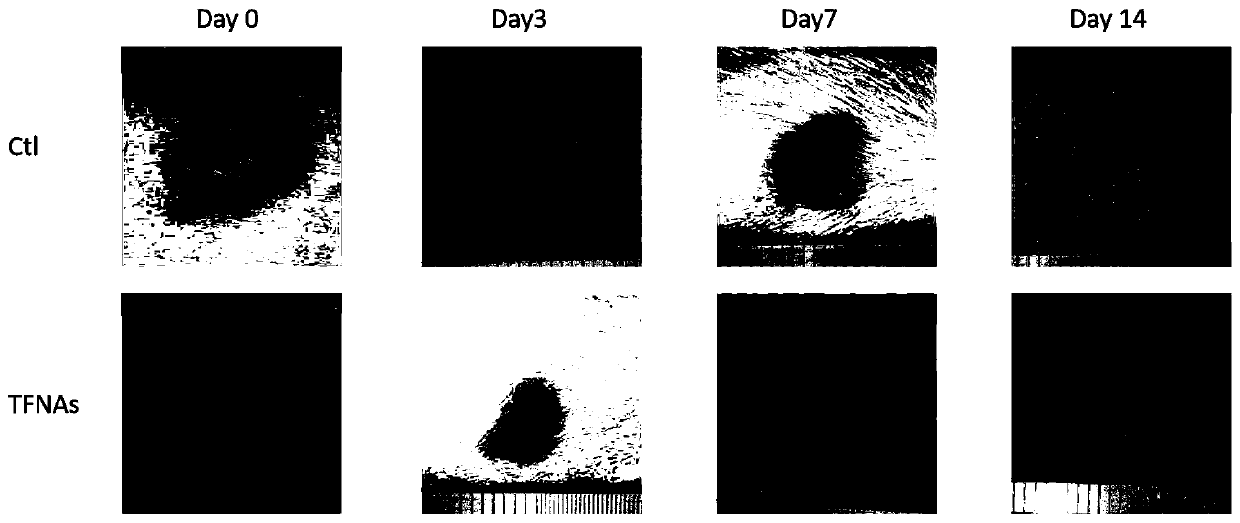Application of tetrahedral skeleton nucleic acid in preparing medicine for skin repairing
A skin repair, tetrahedral technology, applied in the field of medicine, to achieve the effect of promoting migration, promoting skin healing and reducing inflammatory response
- Summary
- Abstract
- Description
- Claims
- Application Information
AI Technical Summary
Problems solved by technology
Method used
Image
Examples
Embodiment 1 4
[0031] Synthesis and Identification of Example 1 Tetrahedral Skeleton Nucleic Acid
[0032] 1. Synthesis method
[0033] Dissolve the four DNA single strands (S1, S2, S3, S4) in TM Buffer (10mM Tris-HCl, 50mM MgCl2, pH=8.0), the final concentration of the four DNA single strands is 1000nM, mix well, and rapidly heat to 95 Keep the temperature at ℃ for 10 minutes, then quickly cool down to 4℃ and keep it for more than 20 minutes to obtain tetrahedral skeleton nucleic acid.
[0034] The sequences of the four single strands (5'→3') are as follows:
[0035] S1: ATTTATCACCCGCCATAGTAGACGTATCACCAGGCAGTTGA
[0036] GACGAACATTCCTAAGTCTGAA (SEQ ID NO. 1)
[0037] S2: ACATGCGAGGGTCCAATACCGACGATTACAGCTGCTACAC
[0038] GATTCAGACTTAGGAATGTTCG (SEQ ID NO. 2)
[0039] S3: ACTACTATGGCGGGTGATAAAACGTGTAGCAAGCTGTAATC
[0040] GACGGGAAGAGCATGCCCATCC (SEQ ID NO. 3)
[0041] S4: ACGGTATTGGACCCTCGCATGACTCAACTGCCTGGTGATAC
[0042] GAGGATGGGCATGCTCTTCCCG (SEQ ID NO. 4)
[0043] 2. Identificati...
Embodiment 2
[0045] Embodiment 2 skin defect repair
[0046] 1. Model animals
[0047] There were 5 SD rats in total. After the back skin was prepared, a circular epithelial full layer with a diameter of 1 cm was taken from the left and right backs with a skin puncher.
[0048] 2. Packet processing
[0049] SD rats were taken as autologous controls, the left side was the control group, and the right side was the experimental group. After the operation to the 7th day after the operation, the wound of the control group was subcutaneously injected with 0.1ml of normal saline in the operation area every day, and the wound of the experimental group was subcutaneously injected with 0.1ml of tetrahedral skeleton nucleic acid (dissolved in normal saline) every day in the wound of the operation area. is 125nM.
[0050] 3. Appearance changes and related index test results
[0051] Take pictures on the 0th, 3rd, 7th, and 14th days and record the wound area, and calculate the wound healing rate = ...
Embodiment 3
[0053] Example 3 Cell scratch experiment
[0054] Inoculate keratinocytes and fibroblasts in 6-well plates (30,000 cells / well) overnight, and use a yellow tip (the tip of a pipette with a capacity of 200 microliters) to draw vertical lines in the wells the next day. Rinse with PBS for 3 times, then add fresh low-serum medium (1% serum), divide into control group (without tetrahedron), 125nM tetrahedron group, 250nM tetrahedron group, take pictures of scratches at 0, 6, and 24h time points of cell migration.
[0055] It can be seen that compared with the control group, the keratinocytes of the 125nM concentration tetrahedron group ( Figure 5 ) and fibroblasts ( Figure 6 ) area of the scratches was significantly reduced, and the cell migration was significantly enhanced. It is believed that the tetrahedron can promote the migration of keratinocytes and fibroblasts.
PUM
 Login to View More
Login to View More Abstract
Description
Claims
Application Information
 Login to View More
Login to View More - R&D
- Intellectual Property
- Life Sciences
- Materials
- Tech Scout
- Unparalleled Data Quality
- Higher Quality Content
- 60% Fewer Hallucinations
Browse by: Latest US Patents, China's latest patents, Technical Efficacy Thesaurus, Application Domain, Technology Topic, Popular Technical Reports.
© 2025 PatSnap. All rights reserved.Legal|Privacy policy|Modern Slavery Act Transparency Statement|Sitemap|About US| Contact US: help@patsnap.com



